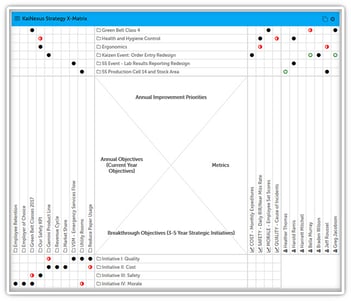 In today's dynamic business landscape, adapting quickly is vital. Continuous improvement processes enable organizations to proactively respond to changes in the marketplace, customer demands, and industry trends. By continuously monitoring and evaluating their operations, businesses can identify emerging challenges and opportunities, adjust strategies, and make informed decisions. This agility helps businesses stay ahead of the competition and remain relevant in an ever-changing environment.
In today's dynamic business landscape, adapting quickly is vital. Continuous improvement processes enable organizations to proactively respond to changes in the marketplace, customer demands, and industry trends. By continuously monitoring and evaluating their operations, businesses can identify emerging challenges and opportunities, adjust strategies, and make informed decisions. This agility helps businesses stay ahead of the competition and remain relevant in an ever-changing environment.
There are many different continuous improvement methodologies that you can implement to achieve more efficient and cost-effective operations. Which one you select depends on the type of business, the nature of your processes, and even your corporate culture. It is worth taking the time to find the continual improvement process ideal for your unique circumstances. This article will explore some options and give you a framework for selecting the right one for your business.
Understanding Continuous Improvement
The continuous improvement model in business refers to an ongoing effort to enhance efficiency, effectiveness, and quality by constantly analyzing and refining processes, products, and services. It involves an ongoing effort to identify areas for improvement, set objectives, implement changes, and evaluate outcomes. Through a culture of continuous improvement, businesses strive to optimize operations, eliminate waste, increase customer satisfaction, and drive innovation. Organizations can achieve sustained growth and gain a competitive advantage in a rapidly evolving business environment by engaging employees, utilizing feedback, and adapting to changing market conditions.
Key Components of a Continuous Improvement Process
Identifying Areas for Improvement
Establishing clear and specific goals is essential for guiding the improvement process. These goals should align with the overall business objectives and be measurable to track progress effectively.
Gathering relevant data is crucial to identify areas that require improvement. This involves collecting data on key performance indicators (KPIs), customer feedback, process metrics, and other relevant information. Analyzing this data helps uncover patterns, trends, and areas of opportunity.
Analyzing Existing Processes
Once data is collected, it is vital to thoroughly analyze existing processes to identify the root causes of problems or inefficiencies. This involves digging deeper to understand the underlying factors contributing to the issues and determining the most effective solutions.
Developing Improvement Strategies
Encouraging employees at all levels to contribute their ideas and suggestions is fundamental to continuous improvement. Brainstorming sessions, team discussions, and suggestion systems can foster creativity and generate innovative improvement strategies.
Implementing Changes
After identifying potential solutions, the next step is to plan and implement the changes. This may involve creating action plans, assigning responsibilities, setting timelines, and allocating resources. Communicating the changes to the relevant stakeholders and ensuring their support and cooperation is essential.
Evaluating the Results
Continuous monitoring and evaluation are essential to determine the effectiveness of the implemented changes. This involves tracking key metrics, comparing performance before and after the improvements, and assessing the impact on the targeted goals. Adjustments can be made as needed to optimize outcomes.
Types of Continuous Improvement Processes
There are several popular types of continuous improvement methods commonly used in businesses. Here are some of the most well-known ones:
Lean Management
Lean management or Lean manufacturing, often associated with the Toyota Production System, focuses on eliminating waste and improving efficiency. It aims to streamline processes, reduce non-value-added activities, optimize resource utilization, and enhance productivity. Lean methodology tools and techniques, such as value stream mapping, 5S methodology, and Kaizen (continuous improvement), are used to identify opportunities, reduce waste, and improve process flow.
Six Sigma
Six Sigma is a data-driven methodology that minimizes process defects and variations. It employs statistical analysis to measure and analyze performance, identify areas of improvement, and reduce process variation. The DMAIC (Define, Measure, Analyze, Improve, Control) approach is commonly used in Six Sigma to guide problem-solving and improvement efforts.
Total Quality Management (TQM)
TQM is a process management philosophy that emphasizes customer satisfaction and continuous improvement. It involves all members of an organization collectively to improve quality and meet or exceed customer expectations.
Agile Methodology
Agile is a project management and software development approach that promotes iterative and incremental improvement. Its core principles include flexibility, collaboration, and adaptability to deliver high-quality products or services.
The PDCA Cycle
The Plan-Do-Check-Act (PDCA) or Deming Cycle is a four-step iterative process for continuous improvement. It starts with planning and setting objectives, followed by implementing the plan (do), checking the results against the objectives (check), and acting upon the findings to make adjustments and improvements (act).
These continuous improvement processes share the goal of driving positive change, enhancing efficiency, and improving customer satisfaction. Each approach offers tools, continuous improvement techniques, and methodologies to address specific improvement needs. Organizations adopt and adapt these processes based on their unique requirements, industry, and organizational culture to achieve continuous improvement and sustainable growth.
When choosing the best one for your team, consider the nature of your opportunities for improvement, the resources available to work on solutions, the technology you have to support continuous improvement efforts, and the sophistication of your facilitators. It is often better to start with a more straightforward approach, such as PDCA, than to implement a more rigid structure, such as Six Sigma. You can introduce new tools and measurement methodologies once you get some quick wins with incremental improvements.
Assessing Business Needs and Goals
The better you understand the state of your current processes and your strategic goals, the more effective you will be at choosing the right continuous improvement approach for your team. Several visual management techniques can help.
The X-Matrix
The term "x-matrix" is commonly used in strategic business planning and is a visual tool that helps organizations align their strategic objectives, measures, targets, and initiatives. The x-matrix is also known as the Hoshin Kanri Matrix or the Strategy Deployment Matrix.
The x-matrix is typically laid out in a tabular format with four key components:
Strategic Objectives: This column outlines the high-level goals and objectives that the organization wants to achieve. These objectives should align with the company's overall vision and mission.
Measures: The measures column specifies the critical performance indicators (KPIs) or metrics that will be used to assess progress toward each strategic objective. These measures should be quantifiable and relevant to the specific objective.
Targets: The targets column defines the specific targets or goals the organization aims to reach for each measure. These targets should be specific, measurable, achievable, relevant, and time-bound (SMART).
Initiatives: The initiatives column lists the specific actions or projects that will be undertaken to support the achievement of each strategic objective. These initiatives should be aligned with the overall strategy and may include projects, programs, process improvements, or other activities.
The x-matrix clearly represents how the strategic objectives, measures, targets, and initiatives are interconnected. It helps organizations align their actions and resources with strategic goals, ensuring a focused and coordinated approach to business planning and continuous improvement.
Value Stream Mapping
While the X-matrix will help align your thinking about your goals and strategic priorities, value stream mapping is a visual method for understanding current processes and identifying opportunities for improvement.
Value stream mapping involves the following key steps:
Identification of the value stream: The first step is identifying the specific process or value stream that will be mapped. This could be a manufacturing process, a service delivery process, or any other activities that create value for the customer.
Current state mapping: The next step involves creating a visual representation of the current state of the value stream. This typically includes mapping out the flow of materials, information, and actions and the time required for each step.
Value-added and non-value-added data analysis: During the current state mapping, value-added and non-value-added activities are distinguished. Value-added activities directly meet customer needs, while non-value-added activities do not add value and can be eliminated or minimized.
Future state mapping: Based on the analysis of the current state, a future state process map is created to represent an ideal or improved state of the value stream. This involves identifying areas for improvement, such as reducing waste, streamlining processes, improving flow, and enhancing overall efficiency.
Implementation plan: Once the future state map is developed, an implementation planning phase is started to guide the necessary changes and achieve continuous improvement. This may involve redesigning processes, implementing new technologies, reorganizing workstations, or introducing lean practices to eliminate waste and enhance value.
Factors to Consider in Choosing a Process
When selecting a continuous improvement process, an organization should consider several factors to ensure its effectiveness and alignment with its goals and culture. These factors include:
Organizational Objectives: The selected continuous improvement process should align with the organization's strategic objectives, goals, and customer expectations. It should improve overall performance, enhance customer satisfaction, reduce costs, increase efficiency, or achieve other desired outcomes.
Organizational Culture: The organization's culture and support of leadership plays a crucial role in the success of continuous improvement efforts. The selected process should be compatible with the existing culture or capable of driving cultural change if necessary. It should promote a collaborative, learning-oriented, and problem-solving mindset among employees.
Resources and Expertise: Consider the availability of resources, including financial resources, skilled personnel, and time. Evaluate whether the organization has the necessary expertise or can acquire the required knowledge and skills to implement and sustain the chosen continuous improvement process.
Scalability and Flexibility: Assess the scalability and flexibility of the continuous improvement process. It should be adaptable to different areas and levels of the organization, allowing for implementation across various departments, teams, or projects. It should also be flexible enough to accommodate changes and adjustments as the organization evolves.
Employee Engagement and Involvement: Consider the level of employee engagement and involvement required by the continuous improvement process. Engaged and empowered employees are essential for successful continuous improvement initiatives. The process should encourage employee participation, collaboration, and ownership of improvement activities.
Data-Driven Approach: Evaluate whether the continuous improvement process emphasizes the collection and analysis of data to drive decision-making. A data-driven approach using the scientific method ensures that improvement efforts are based on accurate information and enables organizations to measure progress and results effectively.
Continuous Learning and Adaptability: Look for a continuous improvement process that promotes a culture of continuous learning and encourages experimentation, innovation, and adaptation. It should support ongoing improvement efforts and be capable of evolving as the organization's needs and challenges change over time.
By considering these factors, organizations can select a continuous improvement process that fits their unique context and maximizes the potential for sustained improvement and success.
Implementation and Integration
Overcoming resistance to change is a common challenge for organizations when implementing new improvement initiatives or making significant changes.
Clear and open communication is crucial to address resistance. Leaders should communicate the reasons for change, its benefits, and its impact on employees. A compelling vision and rationale help employees understand the need for change and reduce uncertainty. Be sure to involve employees and key stakeholders in the change process. Seek their input, listen to their concerns, and actively involve them in decision-making. Employees who feel valued and included are more likely to embrace change rather than resist it.
Foster a supportive environment where employees feel safe to share their concerns and ideas. Encourage collaboration, provide resources, and recognize and reward employees' contributions to the change process. Building a positive and supportive culture facilitates the acceptance of change.
Steps to Implement a Successful Continuous Improvement Process
Step 1: Determine Your Key Processes
Most organizations can't work to improve all processes at the same time, so the first step is to focus on the key processes. Look for processes that have one or more of the following characteristics:
- There are known opportunities for improvement within the process
- Current process results are not meeting expectations
- The process is on the value stream critical path
- Process operators have requested improvement
- The process generates excess waste
Step 2: Define Quality Standards
During this step, you will determine what constitutes success for any process change. The quality metrics will depend on your business and the nature of the process, but organizations often define quality in terms of:
- Customer satisfaction
- The number of defects or amount of rework
- Cycle time
- Safety incidents
- Cost of production
Step 3: Collect and Analyze Data
Before you implement an improvement, gathering data related to your quality standards is necessary so that you understand the current state and can compare the new process to the old.
Step 4: Develop Improvement Plans
Once the data is in hand, the team can work together to suggest and consider opportunities for improvement. Developing improvement plans should be a collaborative effort that involves process operators and other stakeholders, often including internal and external customers of the process.
Step 5: Implement Changes
Once the plan is agreed on, it is time to implement the selected changes. Consider implementing change in smaller, manageable steps rather than a sudden, drastic transformation if possible. The gradual implementation allows employees to adapt incrementally, reducing resistance and increasing the likelihood of successful change.
Step 6: Review and Repeat
With the new process in place, you can review the results against your quality standards and determine whether the change succeeded. Remember that continuous improvement is a never-ending cycle, so the improvement process is repeated repeatedly.
Be sure to acknowledge and celebrate milestones and successes along the way. Recognize and appreciate employees' efforts and accomplishments during the change process. Celebrating progress boosts morale and reinforces the benefits of change.
Monitoring and Evaluating Progress
Continuously gather feedback from employees and monitor the progress of the change initiative. This feedback loop allows organizations to promptly identify and address issues and make necessary adjustments to increase the chances of successful implementation of change.
The monitoring metrics you choose should be consistent with your quality measurements and help you calculate the ROI of improvement. Organizations often select key performance indicators (KPIs) for each process based on its function.
Conclusion: Building a Culture of Continuous Improvement
By following these steps and putting considerable effort into choosing the right process improvement approach for your organization, you put your team on the path to success. Overstating the importance of continuous improvement culture and strong leadership is impossible. With a dedication to ongoing improvement, you can achieve the desired outcomes, increase employee engagement, streamline processes, and achieve continuous positive change.
![[Watch Now] The Why, How, and What of Continuous Improvement](https://no-cache.hubspot.com/cta/default/326641/060c8cc9-44ad-4fd1-ad7b-7b4ab71c7632.png)



Add a Comment